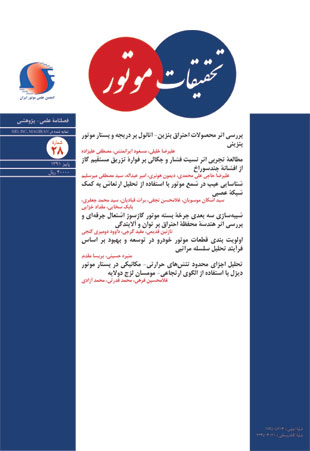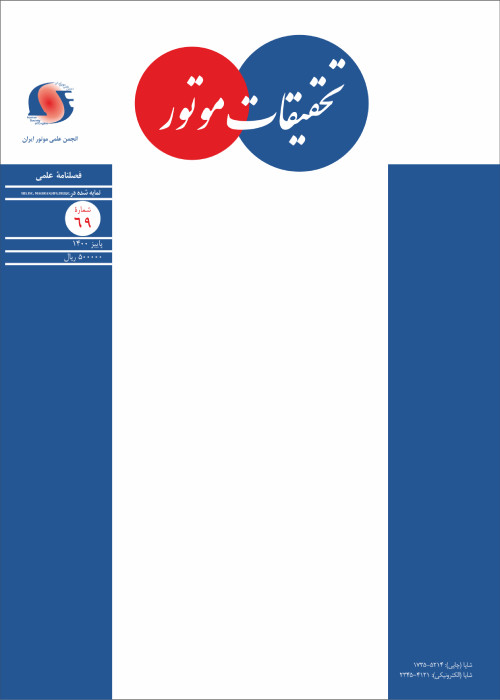فهرست مطالب

نشریه تحقیقات موتور
پیاپی 28 (پاییز 1391)
- تاریخ انتشار: 1391/07/01
- تعداد عناوین: 6
-
-
صفحه 3در این تحقیق تاثیر افزودن درصدهای مختلف اتانول به بنزین بر روی رفتار خوردگی و اکسیداسیون آلیاژهای سوپاپ و سر سیلندر ناشی از محصولات احتراق مورد بررسی قرار گرفته است. به منظور شبیه سازی محیط داغ محفظه سیلندر از یک موتور چهارزمانه تک سیلندر بنزینی استفاده گردید و نمونه های مورد نظر درون لوله اگزوز موتور مذکور جاگذاری و تحت تعداد سیکل معین در معرض محصولات احتراق مخلوط سوخت بنزین- اتانول قرار گرفتند. سپس سطح مقطع نمونه ها جهت ارزیابی پوسته اکسیدی توسط میکروسکوپ الکترونی روبشی (SEM) و سطح نمونه ها جهت ارزیابی میزان اکسیژن موجود توسط تکنیک EDX مورد بررسی قرار گرفت. نتایج بیانگر افزایش ضخامت پوسته اکسیدی با افزایش میزان اتانول و تعداد سیکل کارکرد موتور است. بیشترین میزان تخلخل در پوسته اکسیدی نمونه فولادی در سوخت 15% اتانول با 60 سیکل کارکرد مشاهده شد. میزان فلز از دست رفته در نمونه های فولادی از افزایش چشمگیرتری برخوردار بود که به اکسیداسیون خطی فولاد نسبت داده شد.
کلیدواژگان: اکسیداسیون، اتانول، بنزین، سوپاپ، موتور چهارزمانه -
صفحه 11با توجه به اینکه در موتورهای تزریق مستقیم گاز اشتعال جرقه ای هدایت فواره، زمان بسیار کمی در چرخه کاری موتور به شکل گیری مخلوط اختصاص دارد تعیین دقیق خصوصیات فواره خروجی از افشانه در این موتورها ضرورت می یابد. هدف از اجرای این پژوهش مطالعه اثر نسبت فشار و نسبت چگالی گاز تزریق به گاز داخل محفظه، روی عمق نفوذ محوری و شعاعی و سرعت لبه فواره خروجی از افشانه هفت سوراخ بود. برای این منظور عکسبرداری پرسرعت با بزرگنمایی زیاد در منطقه نزدیک دماغه در بازه زمانی 8/0-0 میلی ثانیه با استفاده از روش شیلرین به عنوان روش آشکارساز فواره گازی شکل مورد استفاده قرار گرفت. عکس های به دست آمده از فواره با استفاده از روش پردازش تصویر نرم افزاری بر مبنای روش لبه یابی، با نوشتن کدی نرم افزاری تحلیل شدند. نتایج نشان دادند که با توجه به منحنی سرعت، شکل گیری فواره تزریق مستقیم گاز خروجی از افشانه چند سوراخ از سه مرحله اصلی نفوذ پلوم های تکی، برخورد پلوم ها و نفوذ فواره اصلی شکل گرفته، تشکیل شده است. تغییر چگالی گاز درون مخزن تاثیری روی زمان های رویداد نقاط حداقل و حداکثر سرعت ندارد. اما در نسبت فشار ثابت با افزایش چگالی گاز داخل محفظه (کاهش نسبت چگالی گاز تزریق به گاز داخل محفظه) عمق نفوذ محوری و سرعت لبه فواره کاهش می یابند ولی عمق نفوذ شعاعی (زاویه گسترش) فواره افزایش می یابد.
کلیدواژگان: تزریق مستقیم گاز، فواره، شیلرین، پردازش تصویر نرم افزاری، افشانه چند سوراخ -
صفحه 21یکی از موارد تاثیرگذار بر روی کیفیت احتراق وضعیت شمع ها است، به طوری که اگر از وضعیت سالم خارج شوند می توانند تاثیرات سویی روی میزان آلایندگی و راندمان موتور داشته باشند. در این مقاله با هدف جلوگیری از اثرات سوء شمع های معیوب، روشی بر پایه تحلیل ارتعاش برای شناسایی عیب در شمع موتور ارائه می شود. سیگنال های ارتعاش موتور توسط یک حسگر شتاب سنج در حالات شمع سالم و معیوب، گرفته شدند. به دلیل وجود نویزهای شدید در سیگنال های منتشره از موتور، تکنیک نویززدایی به منظور حذف این نویزها به کار گرفته شد. سپس برای به دست آوردن اطلاعات مفید تشخیصی از سیگنال های پردازش شده، روش استخراج ویژگی توسط پارامترهای آماری استفاده شد. در این تحقیق 7 ویژگی ماکزیمم، میانگین، انحراف معیار، واریانس، چولگی، کورتسیس و فاکتور ضربه در مرحله استخراج ویژگی به کار گرفته شد. شبکه عصبی با 7 نرون در لایه ورودی تحت فرآیند آموزش قرار گرفت. پس از ایجاد ساختار بهینه، عملکرد شبکه طراحی شده آزمایش شد. نتایج نشان دادند که سطح بالایی از دقت در تشخیص شمع معیوب به دست آمد. بنابراین می توان ذکر کرد که روش پیشنهاد شده می تواند به طور قابل اطمینانی برای شناسایی عیب در شمع موتور مورد استفاده قرار گیرد.
کلیدواژگان: عیب یابی، شمع موتور، تحلیل ارتعاش، نویززدایی، شبکه عصبی -
صفحه 31موتورهای احتراق داخلی مدتهاست که به عنوان موتورهای ثابت در کارخانجات و نیروگاه ها استفاده می شوند. در سال های اخیر تقاضا برای حفاظت محیط زیست و بکارگیری سوخت های جایگزین، بازار تولید را به سمت سامانه های تولید قدرت با استفاده از موتور های گاز سوز بزرگ تحریک کرده است. در این تحقیق، به بررسی اثر عمق کاسه ی پیستون بر روی عملکرد و میزان آلایندگی موتورهای گاز سوز می پردازیم. برای این منظور از دینامیک سیالات محاسباتی سه بعدی برای شبیه سازی سیکل موتور استفاده می گردد. با اعمال معادلات احتراق، آشفتگی و آلایندگی، سیکل بسته موتور یعنی از زمان بسته شدن سوپاپ ورودی هوا تا زمان باز شدن سوپاپ خروجی دود شبیه سازی می شود و نتایج به صورت نمودار و کانتور ارائه می گردد. ابتدا نتایج، با داده های تجربی صحه گذاری شده سپس با شبیه سازی سه شکل پیستون متفاوت، میزان فشار و دمای حاصل شده در داخل سیلندر و مقدار آلایندگی آن ها با هم مقایسه می گردد. نتایج نشان می دهد که پیستونی که بهترین اختلاط و مناسب ترین آشفتگی را در داخل محفظه احتراق ایجاد کند دارای عملکرد بهتر می باشد و میزان آلایندگی کمتری نیز حاصل می دهد.
کلیدواژگان: موتورهای گازسوز سنگین، شکل محفظه احتراق، آلایندگی -
صفحه 51هدف این مقاله، شبیه سازی رفتار حرارتی- مکانیکی بستار موتور دیزل است. این تحلیل اجزای محدود در نرم افزار ABAQUS انجام پذیرفته است. در این راستا، ابتدا برای بیان رفتار ماده، از نتایج آزمون های خستگی کم چرخه در دماهای متفاوت (منحنی هیسترزیس تنش- کرنش مکانیکی در سیکل نیمه عمر) استفاده شده است و ثوابت مادی در الگوی الاستیک- ویسکوپلاستیک دولایه استخراج شده است. آزمون های خستگی با کنترل کرنش و بصورت کشش- فشار بر روی آلیاژ آلومینیوم- سیلیسیوم- منیزیم (A356.0) انجام پذیرفته است. سپس، با استفاده از این ثوابت مادی در دماهای 25، 200 و 250 درجه سانتیگراد، تنش های حرارتی- مکانیکی بستار محاسبه گردیده است. نتایج صحه گذاری نشان داد که الگوی الاستیک- ویسکوپلاستیک دولایه برای تخمین رفتار هیسترزیس آلیاژ آلومینیوم، دقت مناسبی دارد. نتایج شبیه سازی اجزای محدود بستار نیز، نشان دهنده محل ترک خوردگی ها در بین دریچه هاست. به علاوه، مقدار کرنش ویسکوز محاسبه شده، اگرچه کمتر از مقدار کرنش پلاستیک است، اما قابل اغماض نمی باشد.
کلیدواژگان: تحلیل اجزای محدود، تنش ترمومکانیکی، بستار موتور دیزل، الگوی الاستیک، ویسکوپلاستیک دولایه
-
Page 3In the present study, effects of different percentages of ethanol as a gasoline additive on high temperature oxidation behavior of cylinder head and valve alloys were investigated. A single-cylinder four-stroke engine was used to simulate the hot chamber of cylinder environment. Samples were located within the exhaust pipe and were deposited with ethanol blended gasoline combustion gases under certain operating cycles. Then in order to evaluate the oxide layer, the cross-section of samples were observed by scanning electron microscopy (SEM) and to determine the amount of oxygen, the surface of samples were analyzed by energy dispersive X-ray (EDX) technique. The obtained results exhibited that, thickness of oxide film was increased by increasing of the ethanol percentages and engine operating cycles. The most porous film was belonged to steel in 15% ethanol-containing fuel with 60 operating cycles. Metal loss in steel specimens was significantly more due to linear behavior of steel oxidation.Keywords: Oxidation, Ethanol, Gasoline, Valve, Four, stroke engine
-
Page 11As for spray-guided direct injection gaseous fueled engines, a few time is available for mixture preparation, exact determination of the gaseous jet characteristics emanating from the injector is very important. The main purpose of the present work is investigation of the effects of pressure and density ratios on the multi hole gaseous jet tip axial and radial penetration lengths and its velocity. For this, ultra high speed Schlieren imaging of the transient jet with high spatial and temporal resolution was utilized. jet images were analyzed using digital image processing method and the jet characteristics were extracted using an in house software which worked based on edge detection approach. Results revealed that regarding to the velocity curves, formation of the multi-hole gaseous jet is comprised of three stages of: emergence of the individual plumes, merging and penetration of the main spray. It was also found that changing the chamber gas density wouldn’t alter the maximum and minimum times in velocity curves and decreasing the density ratio of the injection gas to chamber gas would decrease axial penetration and jet tip velocity and increase jet spreading angle.Keywords: transient jet, direct injection, Schlieren, high speed imaging
-
Page 21Spark plug condition is an effective parameter on the combustion quality of a spark-ignition (SI) engine. If the condition of spark plug becomes abnormal, engine’s pollution and efficiency will be affected. In the present paper, a procedure is proposed based on vibration analysis for spark plug fault detection. The vibration signals of a SI engine were collected by an accelerometer under two spark plug conditions, namely, normal and abnormal. In order to remove the noises from the signals, wavelet denoising technique was used. Then feature extraction method by statistical parameters was applied to obtain fault-indicating information. In this work, seven feature parameters were employed in the feature extraction stage, namely, maximum, mean, standard deviation, variance, Skewness, Kurtosis and impulse factor. Neural network (NN) was trained with seven neurons in input layer. After constructing the optimum structure, the network’s performance was tested. The results showed that a high level of efficiency was gained in spark plug fault detection. So it can be mentioned that the proposed approach can reliably be used for fault identification in engine spark plug.Keywords: Fault diagnosis, Engine spark plug, Vibration analysis, Denoising, Neural network
-
Page 31Internal combustion engines are used as stationary engines in factories and power plants for a long time. In recent years, the demand for environmental protection and the use of alternative fuels have excited the product market to the power generation systems using heavy duty gas engines. This research activity investigates the effect of piston bowl depth on the performance and emissions of gas engines. Towards this purpose, 3D computational fluid dynamic is used to simulate the cycle engine. By implementing the equations of combustion, turbulence and pollution, close cycle of engine is simulated and the results are presented as graphs and contours. Firstly, results are validated with experimental data and the by simulating of three different pistons, their pressure and temperature inside the cylinder and their amount of emissions are compared.The results show that combustion chamber which creates best mixing and optimum turbulence has the best performance and releases lower emissions.Keywords: heavy duty gas engines, piston shape, emissions
-
Page 51The objective of this article is to simulate the thermal and mechanical behavior of the diesel engine cylinder head. This finite element analysis was performed in the ABAQUS software. Thus، to identify the material behavior، results of low cycle fatigue tests at various temperatures (stress- mechanical strain hysteresis curve at the mid-life cycle) were used and material constants of the two-layer elastic-viscoplastic model were extracted. Fatigue tests were performed in the strain-controlled tensile-compressive condition on the aluminum-silicon-magnesium alloy (A356. 0). Then، by using these material constants at 25، 200 and 250°C، thermal and mechanical stresses of the cylinder head were calculated. The validation result illustrated that the elastic-viscoplastic model has a proper accuracy to predict the hysteresis behavior of the aluminum alloy. Finite elements results showed the location of cracking between valves. In addition، the calculated viscous strain cannot be eliminated، although it is less than the plastic strain.Keywords: Finite element analysis, Thermo, mechanical stress, Diesel engine cylinder head, Two, layer elastic, viscoplastic model


